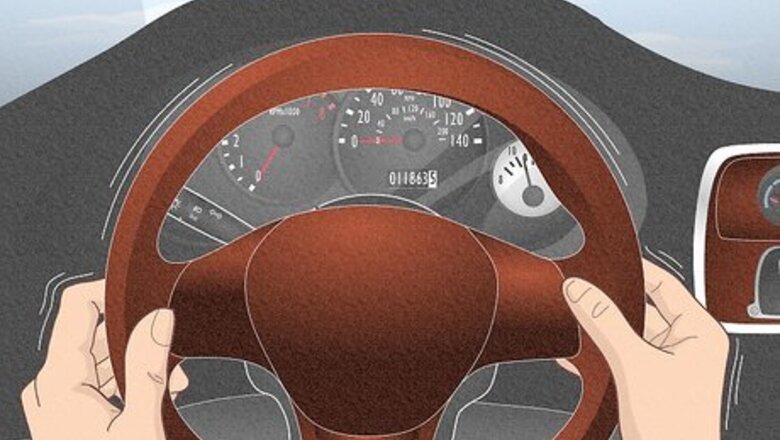
views
- If your steering wheel or brakes vibrate, it usually means your rotors are warped or grooved.
- Blue coloration often indicates prolonged braking, which can lead to overheated rotors.
- Corrosion decreases the friction between the rotor and brake pad, reducing your braking power.
- If you have any signs of a bad rotor, replace them immediately. Additionally, inspect your rotors regularly and replace them after 60-70,000 miles.
Vibrating steering wheel

Vibrations mean your rotors are warped. When braking, your brake pads press down on your rotors, creating friction and heat. Over time, this pressure warps your rotors and makes them uneven, causing a shaky steering wheel. Once your rotors are warped, there’s no way to flatten or repair them. To prevent overheated rotors, avoid speeding and tailgating, which can reduce brake life by about 20%. Steering wheel vibrations are usually a sign that your front rotors are damaged.
Grinding brakes
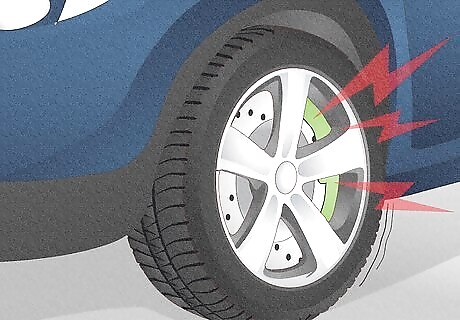
Noisy brakes indicate your rotors aren’t smooth. When your brake pads wear down, their metal backing plate begins to grind against your rotor. Since metal is grinding against metal, this interaction ruins the smooth surface of your rotors, causing a grinding or screeching noise when you step on your brakes. Inspect your brake pad to see how much material is remaining. You may have to remove your wheel to see behind the backing plate, but check if there’s at least 4 mm (0.4 cm) of padding left. Alternatively, grinding brakes can be caused if your brake pads aren’t broken in. To break them in, accelerate to 30-40 MPH before quickly coming to a stop, and then repeat 4-5 times.
Pulsating brakes

Pulsing signals unevenly worn rotors. If your rotor isn’t perfectly flat, it doesn’t properly align with the surface of your brake pads, causing a wobbly or shuddering sensation. Uneven wear is usually caused by overheated rotors or worn out brake pads. Alternatively, uneven rotor wear can be attributed to poor quality control by the manufacturer, so be sure to install high-quality parts for your brake system. It only takes around 0.001 inches (0.003 cm) of thickness variation on the rotor’s surface to cause noticeable vibrations.
Increased stopping distance
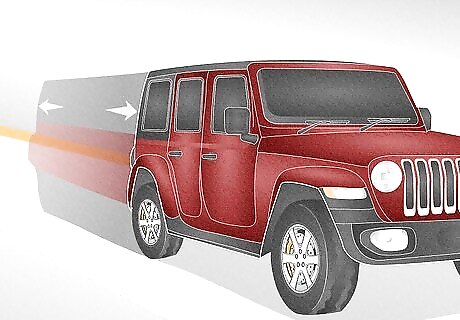
Reduced braking power often indicates glazed pads and rotors. When your brake pads overheat, the outer material hardens and transfers to your rotors. Since the material breaks down, it disrupts the friction between your pads and rotors, resulting in poor brake performance. Alternatively, reduced braking power may occur because there’s oil or grease on your rotors, preventing the brake pads from gripping them. If you’ve done work on your car recently, inspect the surface of your rotors, and use brake cleaner to remove any contaminants.
Blue coloration
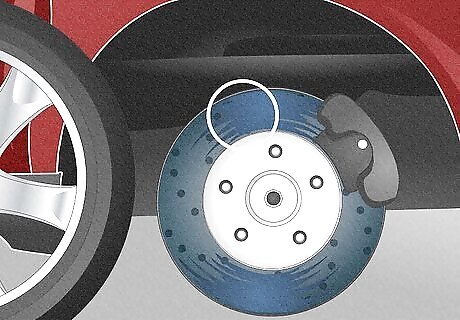
Blue spots show up on your rotor from prolonged braking. The longer you press your brake pedal, the more friction and heat is exposed to your rotor. Over time, this takes a toll on your rotors, especially for drivers who “ride their brakes” to descend hills, curved roads, or mountainous areas. Normal rotors are silver or gray, unless they’re painted with a custom color.
Deep grooves
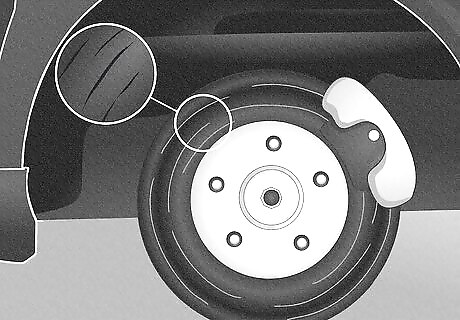
Grooved rotors develop from repeated contact with the brake pads. When your rotors are constantly exposed to heat and friction, they develop score marks or grooves, similar to the lines on a vinyl record. Left untreated, these indents can lead to braking and steering failure because they prevent your rotor from laying flat against the brake pads. Alternatively, visible score marks can form prematurely if there’s a rock stuck between your rotor and rotor shield. If your brakes are acting up, take off your wheel and check the area between your rotor and dust shield. If something’s stuck, you can easily bend the dust shield and let it fall out. If your rotors are in good condition, they should have a smooth surface with minimal imperfections.
Corrosion
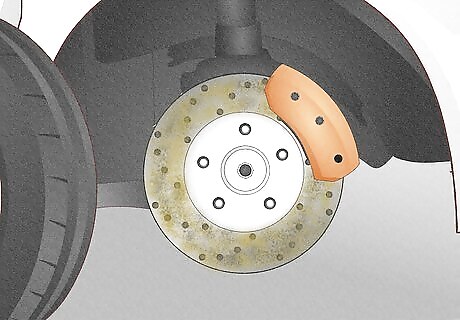
Corrosion occurs when your rotors are exposed to moisture. Since most rotors are made of steel, they’re particularly susceptible to rust. Rain, snow, sleet, and humid conditions can cause surface rust to form in as little as a week, but built-up rust can completely eat away your rotor and create an uneven surface. Rust minimizes the stopping ability of your brake pads, which can cause noise and vibrations. A little surface rust is perfectly normal, but rust builds up quickly if you haven’t engaged your brakes in a while. Be sure to inspect your rotors before driving if you’ve left your car parked for 3-4 weeks. Clean your rotors and brake pads regularly to remove any built-up debris. If there’s a thin layer of rust, you can simply scrub it off with a wire brush and brake cleaner.
Lip around the outer edge

A lip forms on the edge of your rotor when your brake pads wear into it. When your rotor is worn and uneven, it cannot lay flat against the brake pad. Since your brake pad is only able to press against the inner portion of your rotor, it creates a noticeable ridge near the outer edge. To check for a lip, you don’t have to remove your tire. Place your finger on the rotor (the metal disc directly inside the cutout area of your wheels), and feel for a raised area on the outer edge.
Worn-out brake pads
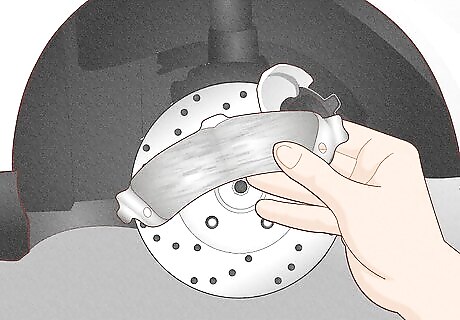
Thin brake pads wear down your rotors and lead to braking problems. Over time, brake pads become thinner with wear, but once their metal backing plate is exposed, it grinds against your rotor and deteriorates it. This can lead to noisy brakes or reduced braking power, so be sure to inspect the thickness of your pads regularly. To measure your brake pad, remove the wheel of your car and locate the pad between the backing plate and rotor. Place a brake pad gauge from the bottom to the top edge of the brake pad, and repeat this measurement at several points to ensure the pad has even thickness. Depending on your vehicle, brake pad thickness varies, but most manufacturers don’t recommend driving with pads thinner than 6.35 mm (0.25 in). Generally, brake pads last 25-60,000 miles, but be sure to measure them if you notice any sounds or vibrations coming from your brakes. A set of front and rear replacement brake pads range from $50-160, but expect to pay anywhere between $200-500 to have them installed.
Thin rotors
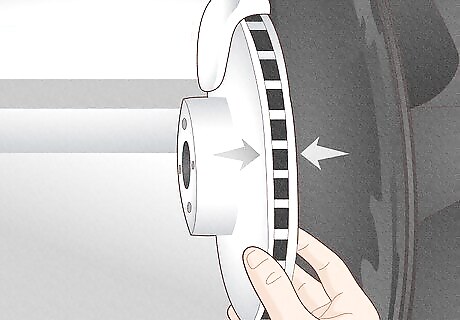
Worn-out rotors crack easily, which can lead to brake failure. Although rotors wear down naturally with age, thin rotors are more susceptible to breakage. To make sure your rotor is safe for the road, check the minimum thickness stamped by the manufacturer on the outer edge or center hat section. To measure your rotor’s thickness, remove the lug nuts and tire and take off the rotor. Use a caliper to measure the rotor at its thinnest point, and then measure at different spots to ensure it has an even surface. Depending on the rotor and manufacturer, the minimum thickness varies, but it’s often 2 mm (0.2 cm) less than a brand new rotor. Thin rotors are also dangerous because they can’t absorb and dissipate heat well, increasing the risk of your brake pads overheating.
Mileage exceeding 60-70,000 miles
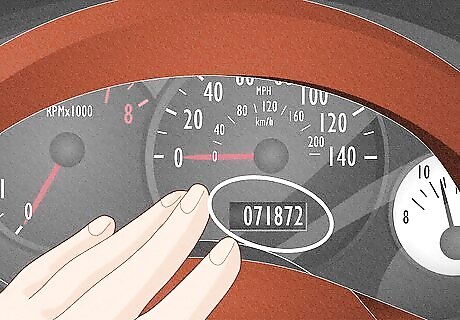
High-mileage vehicles require frequent rotor replacement. When it’s time to replace your brake pads, inspect your rotors too. Rotors are designed to last between 60-70,000 miles, but aggressive driving, thin brake pads, and corrosion can contribute to a shorter life span. If you don’t have any steering or braking issues, your mechanic may surface your rotors instead of replacing them. This involves smoothing out any surface irregularities with a brake lathe. Never resurface your rotors without measuring them first—be sure they haven’t worn down to their minimum thickness. Usually, it’s cheaper to replace your rotors than to resurface them. Rotor resurfacing costs around $60 per rotor, while conventional rotor replacement is about $30. If your rotors have any cracks, grooves, rusting, or blue spots, go ahead and replace them—these are often signs of irreversible damage.




















Comments
0 comment